Yihong Chen
Distance-aware Self-adaptive Graph Convolution for Fine-grained Hierarchical Recommendation
May 14, 2025Abstract:Graph Convolutional Networks (GCNs) are widely used to improve recommendation accuracy and performance by effectively learning the representations of user and item nodes. However, two major challenges remain: (1) the lack of further optimization in the graph representation structure and (2) insufficient attention given to the varying contributions of different convolutional layers.This paper proposes SAGCN, a distance-based adaptive hierarchical aggregation method that refines the aggregation process through differentiated representation metrics. SAGCN introduces a detailed approach to multilayer information aggregation and representation space optimization, enabling the model to learn hierarchical embedding weights based on the distance between hierarchical representations. This innovation allows for more precise cross-layer information aggregation, improves the model's ability to capture hierarchical embeddings, and optimizes the representation space structure. Additionally, the objective loss function is refined to better align with recommendation tasks.Extensive experiments conducted on four real-world datasets demonstrate significant improvements, including over a 5% increase on Yelp and a 5.58% increase in Recall@10 on the ML_1M dataset.
Probing In-Context Learning: Impact of Task Complexity and Model Architecture on Generalization and Efficiency
May 10, 2025Abstract:We investigate in-context learning (ICL) through a meticulous experimental framework that systematically varies task complexity and model architecture. Extending beyond the linear regression baseline, we introduce Gaussian kernel regression and nonlinear dynamical system tasks, which emphasize temporal and recursive reasoning. We evaluate four distinct models: a GPT2-style Transformer, a Transformer with FlashAttention mechanism, a convolutional Hyena-based model, and the Mamba state-space model. Each model is trained from scratch on synthetic datasets and assessed for generalization during testing. Our findings highlight that model architecture significantly shapes ICL performance. The standard Transformer demonstrates robust performance across diverse tasks, while Mamba excels in temporally structured dynamics. Hyena effectively captures long-range dependencies but shows higher variance early in training, and FlashAttention offers computational efficiency but is more sensitive in low-data regimes. Further analysis uncovers locality-induced shortcuts in Gaussian kernel tasks, enhanced nonlinear separability through input range scaling, and the critical role of curriculum learning in mastering high-dimensional tasks.
Multilingual Language Model Pretraining using Machine-translated Data
Feb 18, 2025Abstract:High-resource languages such as English, enables the pretraining of high-quality large language models (LLMs). The same can not be said for most other languages as LLMs still underperform for non-English languages, likely due to a gap in the quality and diversity of the available multilingual pretraining corpora. In this work, we find that machine-translated texts from a single high-quality source language can contribute significantly to the pretraining quality of multilingual LLMs. We translate FineWeb-Edu, a high-quality English web dataset, into nine languages, resulting in a 1.7-trillion-token dataset, which we call TransWebEdu and pretrain a 1.3B-parameter model, TransWebLLM, from scratch on this dataset. Across nine non-English reasoning tasks, we show that TransWebLLM matches or outperforms state-of-the-art multilingual models trained using closed data, such as Llama3.2, Qwen2.5, and Gemma, despite using an order of magnitude less data. We demonstrate that adding less than 5% of TransWebEdu as domain-specific pretraining data sets a new state-of-the-art in Arabic, Italian, Indonesian, Swahili, and Welsh understanding and commonsense reasoning tasks. To promote reproducibility, we release our corpus, models, and training pipeline under Open Source Initiative-approved licenses.
LUNAR: LLM Unlearning via Neural Activation Redirection
Feb 11, 2025Abstract:Large Language Models (LLMs) benefit from training on ever larger amounts of textual data, but as a result, they increasingly incur the risk of leaking private information. The ability to selectively remove knowledge from LLMs is, therefore, a highly desirable capability. In this paper, we propose LUNAR, a novel unlearning methodology grounded in the Linear Representation Hypothesis. LUNAR operates by redirecting the representations of unlearned data to regions that trigger the model's inherent ability to express its inability to answer. LUNAR achieves state-of-the-art unlearning performance while significantly enhancing the controllability of the unlearned model during inference. Specifically, LUNAR achieves between 2.9x to 11.7x improvements on combined "unlearning efficacy" and "model utility" score ("Deviation Score") on the PISTOL dataset across various base models. We also demonstrate, through quantitative analysis and qualitative examples, LUNAR's superior controllability in generating coherent and contextually aware responses, mitigating undesired side effects of existing methods. Moreover, we demonstrate that LUNAR is robust against white-box adversarial attacks and versatile in handling real-world scenarios, such as processing sequential unlearning requests.
MedTet: An Online Motion Model for 4D Heart Reconstruction
Dec 03, 2024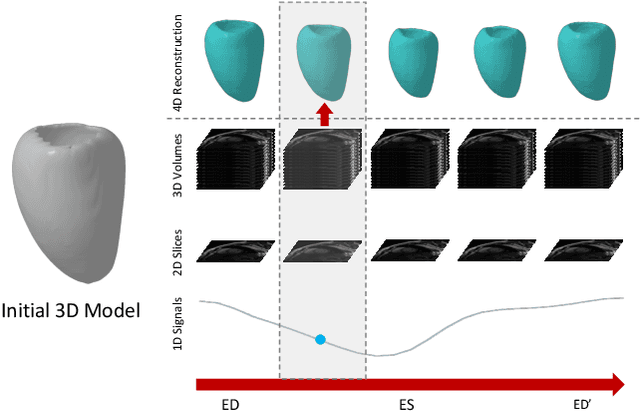

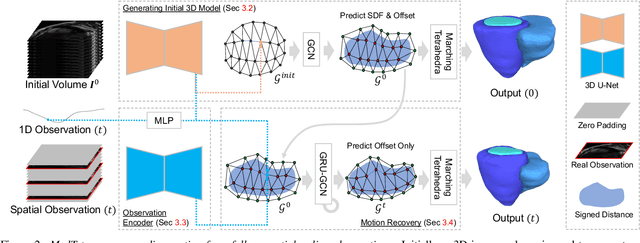
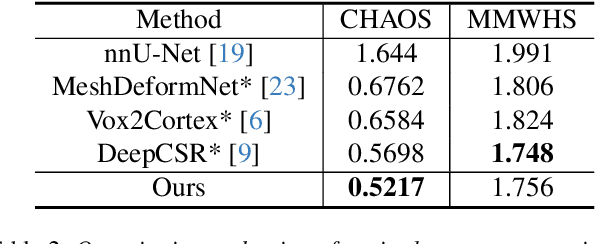
Abstract:We present a novel approach to reconstruction of 3D cardiac motion from sparse intraoperative data. While existing methods can accurately reconstruct 3D organ geometries from full 3D volumetric imaging, they cannot be used during surgical interventions where usually limited observed data, such as a few 2D frames or 1D signals, is available in real-time. We propose a versatile framework for reconstructing 3D motion from such partial data. It discretizes the 3D space into a deformable tetrahedral grid with signed distance values, providing implicit unlimited resolution while maintaining explicit control over motion dynamics. Given an initial 3D model reconstructed from pre-operative full volumetric data, our system, equipped with an universal observation encoder, can reconstruct coherent 3D cardiac motion from full 3D volumes, a few 2D MRI slices or even 1D signals. Extensive experiments on cardiac intervention scenarios demonstrate our ability to generate plausible and anatomically consistent 3D motion reconstructions from various sparse real-time observations, highlighting its potential for multimodal cardiac imaging. Our code and model will be made available at https://github.com/Scalsol/MedTet.
Multilingual Pretraining Using a Large Corpus Machine-Translated from a Single Source Language
Oct 31, 2024
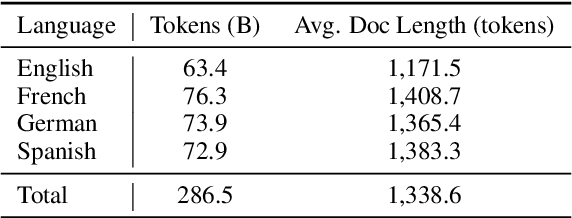
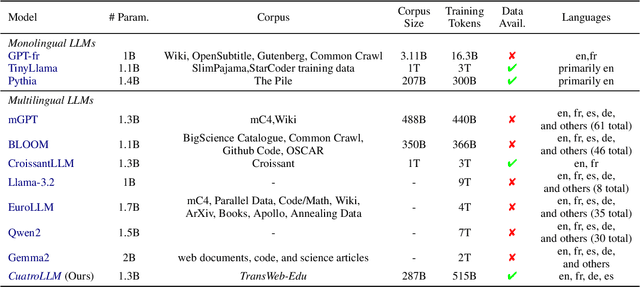

Abstract:English, as a very high-resource language, enables the pretraining of high-quality large language models (LLMs). The same cannot be said for most other languages, as leading LLMs still underperform for non-English languages, likely due to a gap in the quality and diversity of the available multilingual pretraining corpora. In this work, we find that machine-translated text from a single high-quality source language can contribute significantly to the pretraining of multilingual LLMs. We translate FineWeb-Edu, a high-quality English web dataset, into French, German, and Spanish, resulting in a final 300B-token dataset, which we call TransWeb-Edu, and pretrain a 1.3B-parameter model, CuatroLLM, from scratch on this dataset. Across five non-English reasoning tasks, we show that CuatroLLM matches or outperforms state-of-the-art multilingual models trained using closed data, such as Llama3.2 and Gemma2, despite using an order of magnitude less data, such as about 6% of the tokens used for Llama3.2's training. We further demonstrate that with additional domain-specific pretraining, amounting to less than 1% of TransWeb-Edu, CuatroLLM surpasses the state of the art in multilingual reasoning. To promote reproducibility, we release our corpus, models, and training pipeline under open licenses at hf.co/britllm/CuatroLLM.
Jet Expansions of Residual Computation
Oct 08, 2024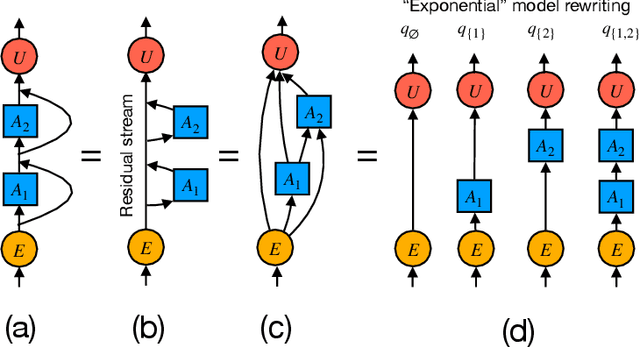

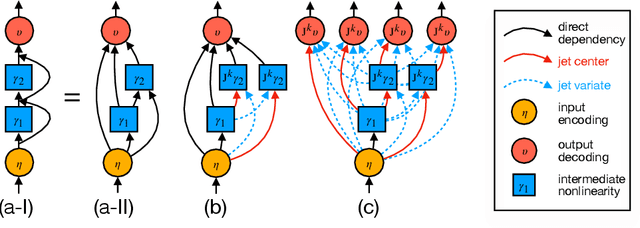
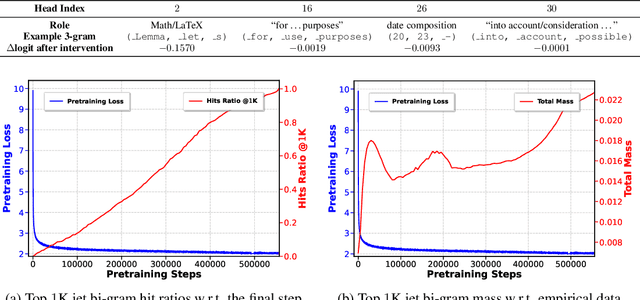
Abstract:We introduce a framework for expanding residual computational graphs using jets, operators that generalize truncated Taylor series. Our method provides a systematic approach to disentangle contributions of different computational paths to model predictions. In contrast to existing techniques such as distillation, probing, or early decoding, our expansions rely solely on the model itself and requires no data, training, or sampling from the model. We demonstrate how our framework grounds and subsumes logit lens, reveals a (super-)exponential path structure in the recursive residual depth and opens up several applications. These include sketching a transformer large language model with $n$-gram statistics extracted from its computations, and indexing the models' levels of toxicity knowledge. Our approach enables data-free analysis of residual computation for model interpretability, development, and evaluation.
AsEP: Benchmarking Deep Learning Methods for Antibody-specific Epitope Prediction
Jul 25, 2024Abstract:Epitope identification is vital for antibody design yet challenging due to the inherent variability in antibodies. While many deep learning methods have been developed for general protein binding site prediction tasks, whether they work for epitope prediction remains an understudied research question. The challenge is also heightened by the lack of a consistent evaluation pipeline with sufficient dataset size and epitope diversity. We introduce a filtered antibody-antigen complex structure dataset, AsEP (Antibody-specific Epitope Prediction). AsEP is the largest of its kind and provides clustered epitope groups, allowing the community to develop and test novel epitope prediction methods. AsEP comes with an easy-to-use interface in Python and pre-built graph representations of each antibody-antigen complex while also supporting customizable embedding methods. Based on this new dataset, we benchmarked various representative general protein-binding site prediction methods and find that their performances are not satisfactory as expected for epitope prediction. We thus propose a new method, WALLE, that leverages both protein language models and graph neural networks. WALLE demonstrate about 5X performance gain over existing methods. Our empirical findings evidence that epitope prediction benefits from combining sequential embeddings provided by language models and geometrical information from graph representations, providing a guideline for future method design. In addition, we reformulate the task as bipartite link prediction, allowing easy model performance attribution and interpretability. We open-source our data and code at https://github.com/biochunan/AsEP-dataset.
PISTOL: Dataset Compilation Pipeline for Structural Unlearning of LLMs
Jun 24, 2024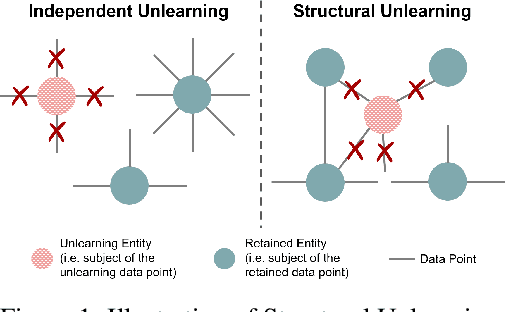
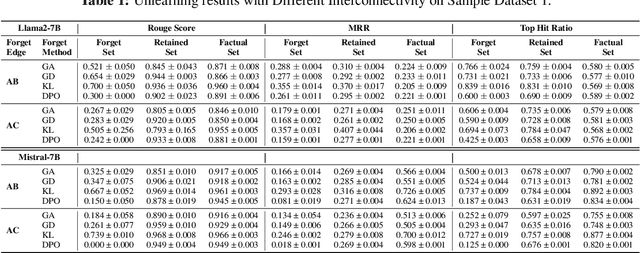

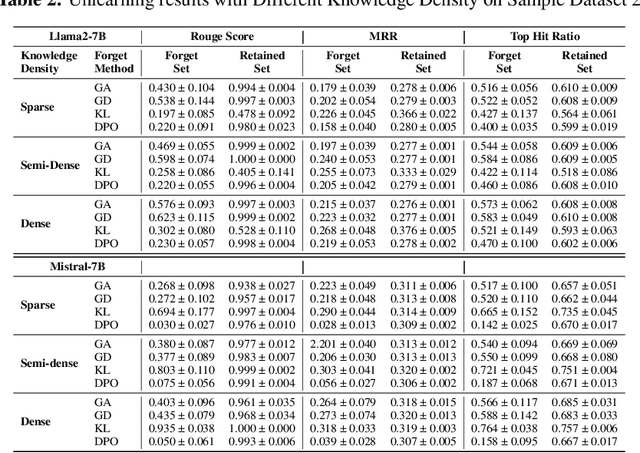
Abstract:Recently, machine unlearning, which seeks to erase specific data stored in the pre-trained or fine-tuned models, has emerged as a crucial protective measure for LLMs. However, unlearning approaches for LLMs that have been considered thus far have focused on the removal of independent data points and have not taken into account that the stored facts are logically connected to one another and form an implicit knowledge graph. To facilitate the development of structural unlearning methods, which are essential for the practical application of unlearning, we propose PISTOL, a pipeline for compiling multi-scenario datasets for benchmarking structural LLM unlearning. Additionally, leveraging sample datasets synthesized using PISTOL, we conducted benchmarks with four distinct unlearning methods on both Llama2-7B and Mistral-7B models. This analysis helps to illustrate the prevailing challenges in effectively and robustly removing highly inter-connected data, batched data, or data skewed towards a specific domain. It also highlights the choice of pre-trained model can impact unlearning performance. This work not only advances our understandings on the limitation of current LLMs unlearning methods and proposes future research directions, but also provides a replicable framework for ongoing exploration and validation in the field.
NAFRSSR: a Lightweight Recursive Network for Efficient Stereo Image Super-Resolution
May 14, 2024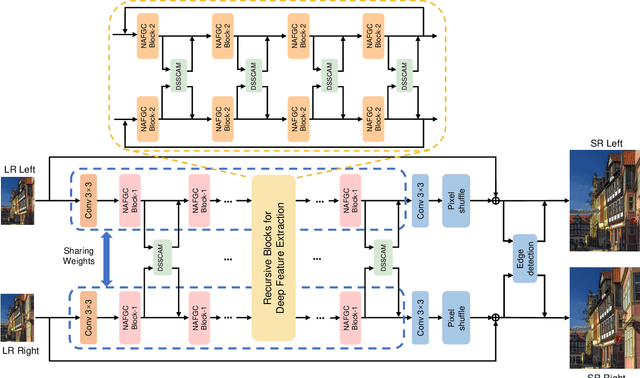
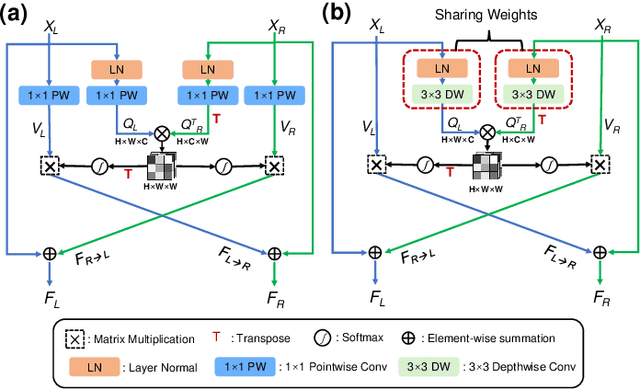
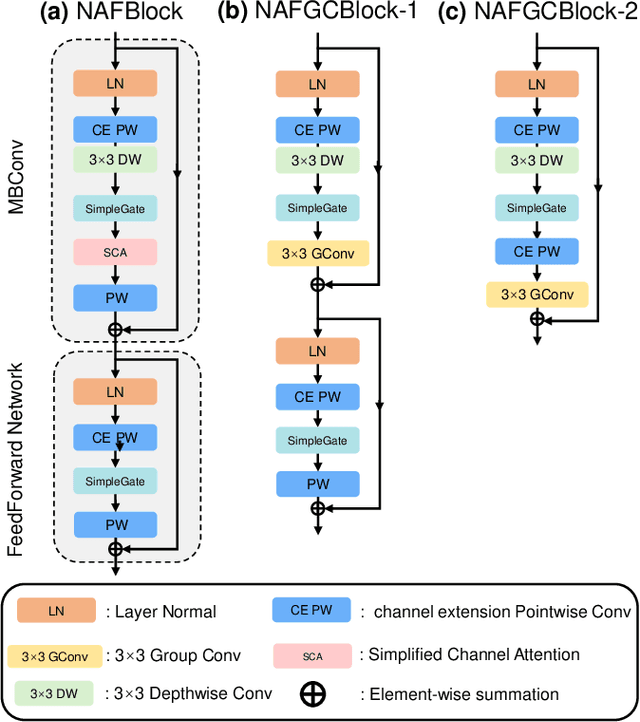
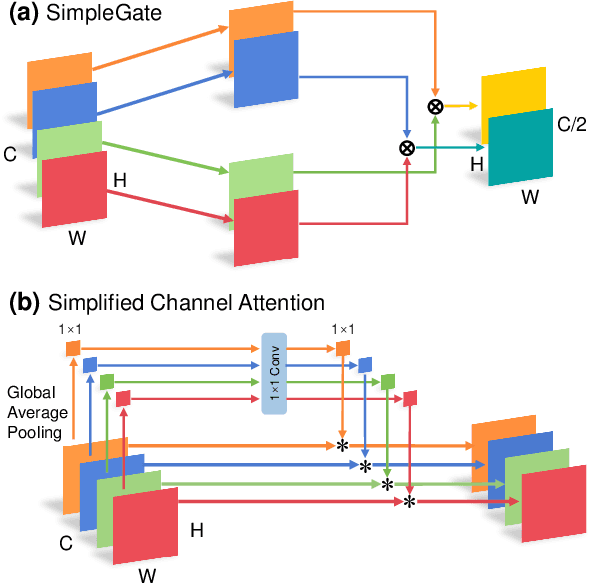
Abstract:Stereo image super-resolution (SR) refers to the reconstruction of a high-resolution (HR) image from a pair of low-resolution (LR) images as typically captured by a dual-camera device. To enhance the quality of SR images, most previous studies focused on increasing the number and size of feature maps and introducing complex and computationally intensive structures, resulting in models with high computational complexity. Here, we propose a simple yet efficient stereo image SR model called NAFRSSR, which is modified from the previous state-of-the-art model NAFSSR by introducing recursive connections and lightweighting the constituent modules. Our NAFRSSR model is composed of nonlinear activation free and group convolution-based blocks (NAFGCBlocks) and depth-separated stereo cross attention modules (DSSCAMs). The NAFGCBlock improves feature extraction and reduces number of parameters by removing the simple channel attention mechanism from NAFBlock and using group convolution. The DSSCAM enhances feature fusion and reduces number of parameters by replacing 1x1 pointwise convolution in SCAM with weight-shared 3x3 depthwise convolution. Besides, we propose to incorporate trainable edge detection operator into NAFRSSR to further improve the model performance. Four variants of NAFRSSR with different sizes, namely, NAFRSSR-Mobile (NAFRSSR-M), NAFRSSR-Tiny (NAFRSSR-T), NAFRSSR-Super (NAFRSSR-S) and NAFRSSR-Base (NAFRSSR-B) are designed, and they all exhibit fewer parameters, higher PSNR/SSIM, and faster speed than the previous state-of-the-art models. In particular, to the best of our knowledge, NAFRSSR-M is the lightest (0.28M parameters) and fastest (50 ms inference time) model achieving an average PSNR/SSIM as high as 24.657 dB/0.7622 on the benchmark datasets. Codes and models will be released at https://github.com/JNUChenYiHong/NAFRSSR.
 Add to Chrome
Add to Chrome Add to Firefox
Add to Firefox Add to Edge
Add to Edge